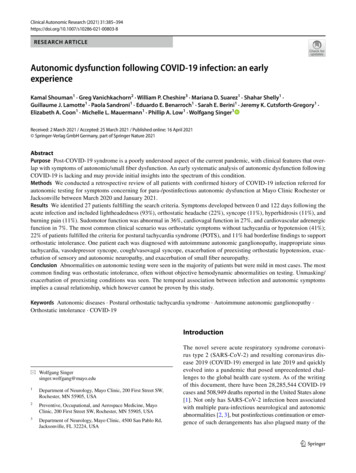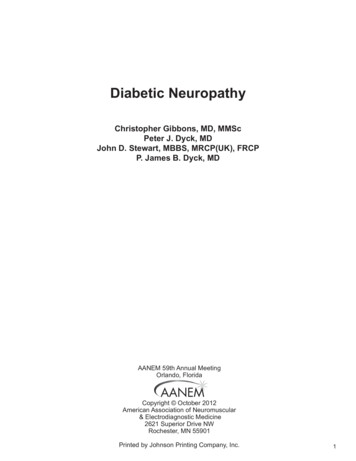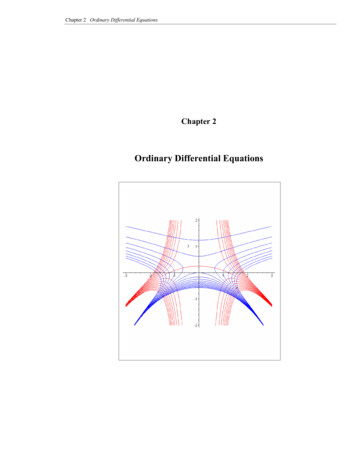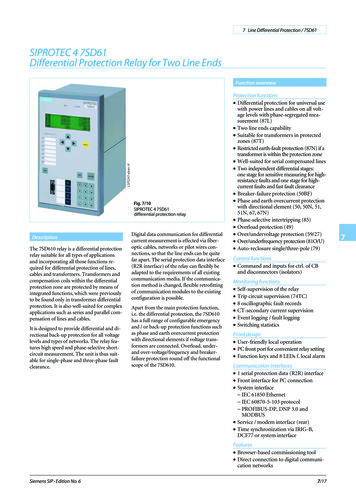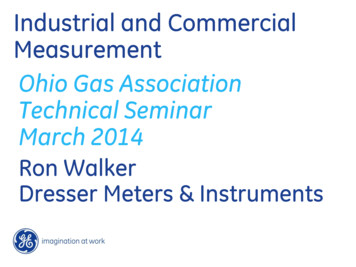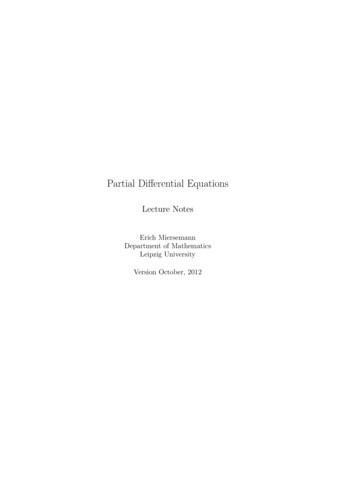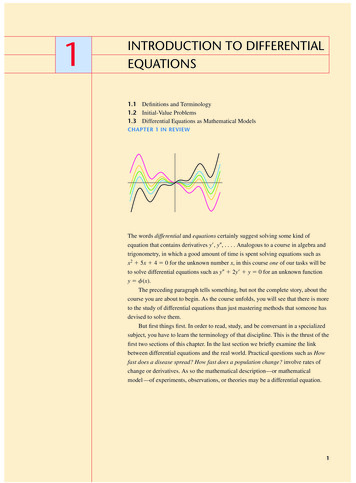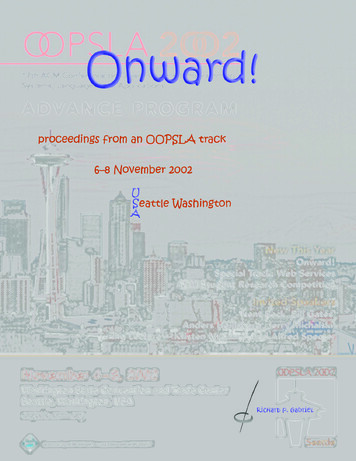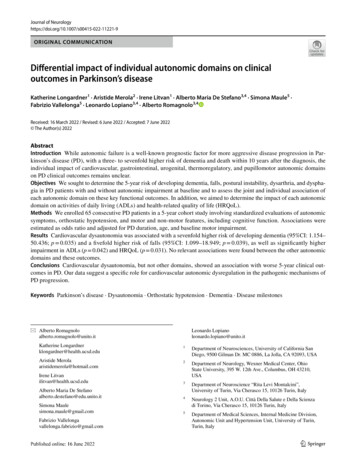
Transcription
Journal of 9ORIGINAL COMMUNICATIONDifferential impact of individual autonomic domains on clinicaloutcomes in Parkinson’s diseaseKatherine Longardner1 · Aristide Merola2 · Irene Litvan1 · Alberto Maria De Stefano3,4 · Simona Maule5 ·Fabrizio Vallelonga5 · Leonardo Lopiano3,4 · Alberto Romagnolo3,4Received: 16 March 2022 / Revised: 6 June 2022 / Accepted: 7 June 2022 The Author(s) 2022AbstractIntroduction While autonomic failure is a well-known prognostic factor for more aggressive disease progression in Parkinson’s disease (PD), with a three- to sevenfold higher risk of dementia and death within 10 years after the diagnosis, theindividual impact of cardiovascular, gastrointestinal, urogenital, thermoregulatory, and pupillomotor autonomic domainson PD clinical outcomes remains unclear.Objectives We sought to determine the 5-year risk of developing dementia, falls, postural instability, dysarthria, and dysphagia in PD patients with and without autonomic impairment at baseline and to assess the joint and individual association ofeach autonomic domain on these key functional outcomes. In addition, we aimed to determine the impact of each autonomicdomain on activities of daily living (ADLs) and health-related quality of life (HRQoL).Methods We enrolled 65 consecutive PD patients in a 5-year cohort study involving standardized evaluations of autonomicsymptoms, orthostatic hypotension, and motor and non-motor features, including cognitive function. Associations wereestimated as odds ratio and adjusted for PD duration, age, and baseline motor impairment.Results Cardiovascular dysautonomia was associated with a sevenfold higher risk of developing dementia (95%CI: 1.154–50.436; p 0.035) and a fivefold higher risk of falls (95%CI: 1.099–18.949; p 0.039), as well as significantly higherimpairment in ADLs (p 0.042) and HRQoL (p 0.031). No relevant associations were found between the other autonomicdomains and these outcomes.Conclusions Cardiovascular dysautonomia, but not other domains, showed an association with worse 5-year clinical outcomes in PD. Our data suggest a specific role for cardiovascular autonomic dysregulation in the pathogenic mechanisms ofPD progression.Keywords Parkinson’s disease · Dysautonomia · Orthostatic hypotension · Dementia · Disease milestonesLeonardo Lopianoleonardo.lopiano@unito.it* Alberto Romagnoloalberto.romagnolo@unito.itKatherine Longardnerklongardner@health.ucsd.edu1Aristide Merolaaristidemerola@hotmail.comDepartment of Neurosciences, University of California SanDiego, 9500 Gilman Dr. MC 0886, La Jolla, CA 92093, USA2Irene Litvanilitvan@health.ucsd.eduDepartment of Neurology, Wexner Medical Center, OhioState University, 395 W. 12th Ave., Columbus, OH 43210,USA3Alberto Maria De Stefanoalberto.destefano@edu.unito.itDepartment of Neuroscience “Rita Levi Montalcini”,University of Turin, Via Cherasco 15, 10126 Turin, Italy4Simona Maulesimona.maule@gmail.comNeurology 2 Unit, A.O.U. Città Della Salute e Della Scienzadi Torino, Via Cherasco 15, 10126 Turin, Italy5Department of Medical Sciences, Internal Medicine Division,Autonomic Unit and Hypertension Unit, University of Turin,Turin, ItalyFabrizio 3456789)
Journal of NeurologyIntroductionIt has been estimated that 50–70% of individuals with Parkinson’s disease (PD) experience disturbances from autonomic nervous system failure, including cardiovascular,urogenital, gastrointestinal, thermoregulatory, and pupillomotor dysfunction [1–3]. Previous studies showed that general dysautonomia, and neurogenic orthostatic hypotension(OH) in particular, are associated with negative health outcomes in PD, including faster motor and cognitive decline,more frequent falls and hospitalizations, and a higher riskof developing dementia, disability, and death [4–7]. Still,the individual impact of each autonomic domain on diseaseprogression and whether autonomic disturbances contribute directly to worse outcomes (e.g., extreme hemodynamicfluctuations potentially causing repeated cerebral hypoperfusion) or are merely associated with them (i.e., a marker of amore aggressive disease phenotype) remains unclear [8, 9].In this 5-year prospective observational study, our primary aim was to determine the individual and joint association of each autonomic domain on developing criticalPD disability milestones, including dementia, falls, postural instability, dysarthria, and dysphagia. Our secondaryaim was to determine the impact of autonomic domains onprogression of activities of daily living (ADLs) and healthrelated quality of life (HRQoL) impairment. Furthermore,we investigated the association between clinically definedOH and these outcomes.MethodsStudy designThis single-center, prospective, observational cohort studyaimed to evaluate the impact of autonomic symptoms on disability milestones and functional outcomes in PD. Consecutive participants were enrolled from the Movement DisordersCenter of the University of Torino between April 2015 andMarch 2016. The local institutional review board approvedthe study, and all participants gave written informed consent.Eligibility criteriaInclusion criteria were as follows: PD diagnosed accordingto the United Kingdom Brain Bank Criteria [10]; diseaseduration at least two years at baseline; age between 18 and80 years; and stable dose of dopaminergic therapy and/orantihypotensive or antihypertensive medications for at least4 weeks. Exclusion criteria were neurological signs suggestive of a diagnosis other than idiopathic PD; diabetes13mellitus or other condition associated with autonomic neuropathy [11]; cardiac arrhythmia or coronary artery disease,cardiac valve disease or clinically relevant cardiac structuralabnormalities; severe chronic renal insufficiency (glomerular filtration rate 30 ml/min); undergoing chemotherapy;monoclonal gammopathy of uncertain significance (MGUS);major psychiatric disorder in accordance with Diagnosticand Statistical Manual of Mental Disorders (DSM) 5thed. Criteria (American Psychiatric Association, 2013); ortreatment with alpha-adrenergic antagonists for prostaticdisorders.Baseline assessmentsClinical and demographic data at baseline included age,medical history, and duration of PD from symptom onset.All medications were recorded and the levodopa equivalentdaily dose (LEDD) calculated according to the conversiontable proposed by Tomlisonet al. [12].Clinical rating scales included motor assessment usingthe Movement Disorder Society-Unified Parkinson's DiseaseRating Scale (MDS-UPDRS) Part III (motor examination)[12] during the best “on” state, defined as the period of perceived maximal efficacy from dopaminergic medications.Non-motor symptoms were assessed using the Non-MotorSymptoms Scale (NMSS) [13].Autonomic and blood pressure (BP) assessments includedthe validated 25-item Scale for Outcomes in Parkinson’sDisease-Autonomic (SCOPA-AUT), a one-dimensionallinear scale with high internal construct validity [14]. Thefollowing SCOPA-AUT subscales were independentlyrated: gastrointestinal (items 1–7); urogenital (8–13, formen 22–23 and for women 24–25); cardiovascular (14–16);thermoregulatory (17–18, 20–21); and pupillomotor (19).The impairment of an autonomic domain was defined whenaccording to symptoms experienced in the past month atleast one of the related items was rated 2; wherein 0, never;1, sometimes; 2, regularly; and 3, often [15].Patients underwent BP measurements using an automatedsphygmomanometer (HEM-7200—Omron Healthcare Co.Kyoto, Japan) placed at heart level on the left arm, in thefollowing conditions: (a) while sitting in a chair after at least10 min of rest; (b) after a minimum of 10 min of supine rest;and (c) after one and three minutes of active standing. Tominimize BP variability due to antiparkinsonian medications, patients were evaluated in standardized conditions. BPassessments were performed in the morning in the best “on”state, and at least 3 h after a meal. OH was defined as a BPdrop 20 mmHg systolic or 10 mmHg diastolic within 3 minof standing from a supine position [16]. Patients with a risein heart rate (HR)/fall in systolic BP ratio 0.5 beats perminute (bpm)/mmHg [17] were considered as having nonneurogenic OH (i.e., due to iatrogenic cause, dehydration,
Journal of Neurologyvenous pooling in the lower limbs, cardiac failure, etc.) andwere excluded from the OH analyses. Hemodynamicallyrelevant OH was defined as orthostatic mean arterial pressure (MAP) 75 mmHg [18]. Supine hypertension (SH)was defined as supine systolic BP 140 mmHg or diastolicBP 90 mmHg in patients affected by neurogenic OH (nOH)[19].Functional and cognitive assessments included the MDSUPDRS Parts I (non-motor experience of daily living), II(motor experience of daily living), and IV (motor complications) [13]; Montreal Cognitive Assessment (MoCA;range 0–30, lower is worse) [20]; and the 8-item PD Qualityof Life Questionnaire (PDQ-8 single index; range 0–100,higher is worse) [21].Follow‑up assessmentsAfter 5 years, the patients underwent the following assessments to evaluate functional outcomes, independence inADLs, and HRQoL: MDS-UPDRS Parts I and II, MoCA,and PDQ-8; the number of falls in the previous 4 weeks.Five specific disability milestones were chosen to definedisease progression, including the following: (1) dementia,defined as MoCA score 21/30 [22]; (2) falls in the 4 weeksprior to the evaluation; (3) postural instability, defined asa score 3 of item 3.12 of the MDS-UPDRS; (4) dysphagia, defined as a score 3 of item 2.3 of the MDS-UPDRS;and (5) dysarthria, defined as a score 3 of item 2.1 of theMDS-UPDRS.Outcome measures and statistical analysesOur primary aim was to evaluate the 5-year risk of developing the five key disability milestones listed above in patientswith and without PD-associated autonomic symptoms andwith and without nOH at baseline, evaluating the individualand joint impact of each autonomic domain. Our secondaryaim was to determine the role of autonomic dysfunction andnOH in progression of ADL and HRQoL impairment.Primary endpoints were dementia, falls, postural instability, dysphagia, and dysarthria. A binary logistic regressionwas used to estimate the odds ratio (OR) of global autonomicimpairment at baseline, as measured by the total SCOPAAUT score, and of each individual autonomic domainimpairment (independent variables) on the occurrence ofdisability milestones along the 5-year follow-up (dependentvariables), adjusting for age, disease duration, and motorsymptom severity (MDS-UPDRS Part III) at baseline. Thelogistic regression was run twice as follows: (a) considering SCOPA-AUT and each autonomic domain separately(univariate); and (b) considering all the autonomic domainstogether (multivariate). Only for dementia, the analyses wererun including the entire sample and, then again, excludingthe individuals who had dementia at baseline. The sameanalyses were used to evaluate the association between nOHat baseline and disability milestones, and between hemodynamically relevant nOH and disability milestones. A subanalysis on the impact of SH associated with nOH was alsoincluded. The Hosmer and Lemeshow’s goodness-of-fit testwas applied.Secondary endpoints included impairment of ADLs, asmeasured by the MDS-UPDRS Parts I and II, and HRQoL,as measured by the PDQ-8. A repeated-measures ANOVAwas used to evaluate progression independent variables(MDS-UPDRS Part I, Part II, Parts I II combined, andPDQ-8), adjusting for age, disease duration, and motorsymptom severity at baseline (covariates), between patientswith and without the following conditions: (a) impairmentin each autonomic domain; (b) nOH; and (c) hemodynamically relevant nOH.Clinical and demographic characteristics were summarized as mean standard deviation and range or absolutenumber and percentages, as appropriate. The differencesbetween SCOPA-AUT, MDS-UPDRS Parts I and II, MoCA,and PDQ-8 scores at baseline and at 5-year follow-up wereevaluated by means of the Wilcoxon non-parametric test.All the analyses were performed with Statistical Package forthe Social Sciences (SPSS 27.0 for Macintosh, Chicago, IL),using two-tailed p-values with a level of significance of 0.05.Data availabilityThe data that support the findings of this study are availablefrom the corresponding author, upon reasonable request.ResultsOut of the 65 PD patients enrolled in the study, nine (15.3%)died during the observational study period (mean time frombaseline: 29.7 7.7 months), and six (9.2%) were lost tofollow-up (Supplementary Table 1). Thus, 5-year followup data were available for 50 patients (Tables 1 and 2),and showed a 66.9% overall progression in global ADLimpairment (MDS-UPDRS Parts I II: from 23.1 10.3 to38.6 17.8; p 0.001) and a significant 81.4% worsening inHRQoL (PDQ-8: from 22.6 19.0 to 41.0 29.4; p 0.001).MoCA score significantly declined by 12.3% (from26.1 3.5 to 22.9 5.4; p 0.001), with the prevalence ofdemented patients rising from 8.0% (4/50) to 30% (15/50);the 5-year incidence of dementia was 23.9% (11/46).The vast majority of patients (86.0%) reported a significant progression in their baseline autonomic symptomsover follow-up, with the SCOPA-AUT total score increasingfrom 13.1 8.7 at baseline to 21.3 10.4 points at year 5(62.6% worsening) (p 0.001). The gastrointestinal domain13
Journal of NeurologyTable 1 Demographic and clinical characteristics at baselineTable 2 Demographic and clinical characteristics at 5-year follow-upSex (males/females)Age (years)Disease duration RS-IVHoehn and Yahr stageTotal LEDD (mg)NMSSSCOPA-AUT Gastrointestinal domain impairment (yes/no)Urogenital domain impairment (yes/no)Cardiovascular domain impairment (yes/no)Thermoregulatory domain impairment(yes/no)Pupillomotor domain impairment (yes/no)Neurogenic OH (yes/no)Hemodynamically relevant OH (yes/no)Supine hypertension (yes/no)MoCADementia (yes/no)PDQ-8 single indexSex (males/females)Age (years)Disease duration (years)MDS-UPDRS-IMDS-UPDRS-IIMDS-UPDRS-IVTotal LEDD (mg)NMSSSCOPA-AUT MoCADementia (yes/no)Falls (yes/no)Dysphagia (yes/no)Postural instability (yes/no)Dysarthria (yes/no)PDQ-8 single index30/20 (60%/40%)64.3 9.4 (38–80)12.8 6.1 (2–26)12.0 5.5 (3–30)11.1 5.8 (2–26)28.2 14.1 (3–66)3.8 3.7 (0–14)2.5 0.6 (2–4)935.9 538.8 (100–2100)34.6 24.2 (3–110)13.1 8.7 (0–34)32/18 (64%/36%)34/16 (68%/32%)10/40 (20%/80%)19/31 (38%/62%)11/39 (22%/78%)13/37 (26%/74%)10/40 (20%/80%)6/7 (46.2%/53.8%)26.1 3.5 (14–30)4/46 (8%/92%)22.6 19.0 (0.0–81.2)Results are reported as mean standard deviation (range) or absolutevalues (percentage), as appropriate. Supine hypertension refers onlyto patients affected by neurogenic OHLEDD, Levodopa Equivalent Daily Dose; MDS-UPDRS, MovementDisorders Society Unified Parkinson’s Disease Rating Scale; MoCA,Montreal Cognitive Assessment; NMSS, Non-Motor Symptom Scale;OH, Orthostatic Hypotension; PDQ-8, Parkinson’s Disease Questionaire-8; SCOPA-AUT, Scale for Outcomes in Parkinson’s DiseaseAutonomicworsened by 70.3% (from 3.7 2.9 to 6.3 3.8; p 0.001),the urogenital by 55.4% (from 5.6 5.2 to 8.7 5.2;p 0.001), the cardiovascular by 66.7% (from 1.2 1.9 to2.0 2.3; p 0.001); the thermoregulatory by 54.5% (from2.2 2.5 to 3.4 3.1; p 0.008), and the pupillomotor by125% (from 0.4 0.7 to 0.9 1.0; p 0.002).Dysautonomia and disability milestonesThe total SCOPA-AUT score was not associated with anyof the disability milestones evaluated: dementia (p 0.478),falls (p 0.790), postural instability (p 0.326), or dysphagia (p 0.253), with a trend towards statistical significanceonly for dysarthria (p 0.061) (Table 3). However, the cardiovascular score was independently associated with a higherrisk of developing dementia, both in the univariate and inthe multivariate analysis (OR: 9.058; 95% CI: 1.548–53.000;1330/20 (60.0%/40.0%)69.3 9.4 (43–85)17.8 6.1 (6–31)16.2 8.2 (1–36)22.4 11.4 (3–44)6.5 5.9 (0–24)960.0 484.9 (200–2150)74.4 55.9 (9–246)21.3 10.4 (6–48)22.9 5.4 (10–29)15/35 (30.0%/70.0%)31/19 (62.0%/38.0%)13/37 (26.0%/74.0%)28/22 (56.0%/44.0%)18/32 (36.0%/64.0%)41.0 29.4 (0.0–93.7)Results are reported as mean standard deviation (range) or absolutevalues (percentage), as appropriateLEDD, Levodopa Equivalent Daily Dose; MDS-UPDRS, MovementDisorders Society Unified Parkinson’s Disease Rating Scale; MoCA,Montreal Cognitive Assessment; NMSS, Non-Motor Symptom Scale;PDQ-8, Parkinson’s Disease Questionaire-8; SCOPA-AUT, Scale forOutcomes in Parkinson’s Disease-Autonomicp 0.014; and OR: 7.630; 95% CI: 1.154–50.436; p 0.035,respectively) (Table 3) and with falls in the univariate analysis (OR: 5.701; 95% CI: 1.099–18.949; p 0.039) (Table 3).None of the autonomic domains were associated with postural instability, dysphagia, or dysarthria (Table 3).Neurogenic OH and disability milestonesAt baseline, 13/50 patients (28.8%) had clinically definednOH (Table 1), with 10 of those patients (76.9%) meetingthe criteria for hemodynamically relevant OH. Four patients(30.8%) with nOH did not report significant OH-relatedsymptoms on the SCOPA-AUT evaluation; despite that, twoof them (50%; one demented and one non-demented) hadhemodynamically relevant nOH. Only one patient reportedcardiovascular dysautonomia symptoms without having OH.Six out of 13 patients with nOH (46.2%) met the criteriafor SH (Table 1). Finally, two patients had non-neurogenicOH. The presence of nOH at baseline, after correcting forage, disease duration, and motor impairment, was associated with dementia at the 5-year follow-up (OR: 5.213; 95%CI: 1.194–24.391; p 0.036), even after removing patientsalready affected by dementia at baseline (OR: 5.153; 95% CI:1.289–26.943; p 0.029). This association was even strongerwhen considering patients with concomitant SH (OR: 8.265;95% CI: 2.026–32.103; p 0.012). nOH was also associatedwith falls (OR: 7.129; 95% CI: 1.212–41.921; p 0.030),
Journal of NeurologyTable 3 Analysis of association between dysautonomia and disability milestonesDysautonomic featuresUnivariateOR (95%CI)DementiaSCOPA-AUT (total score)Gastrointestinal domain impairmentUrogenital domain impairmentCardiovascular domain impairmentThermoregulatory domain impairmentPupillomotor domain impairmentAfter removing patients with dementia at baselineSCOPA-AUT (total score)Gastrointestinal domain impairmentUrogenital domain impairmentCardiovascular domain impairmentThermoregulatory domain impairmentPupillomotor domain impairmentFallsSCOPA-AUT (total score)Gastrointestinal domain impairmentUrogenital domain impairmentCardiovascular domain impairmentThermoregulatory domain impairmentPupillomotor domain impairmentDysphagiaSCOPA-AUT (total score)Gastrointestinal domain impairmentUrogenital domain impairmentCardiovascular domain impairmentThermoregulatory domain impairmentPupillomotor domain impairmentDysarthriaSCOPA-AUT (total score)Gastrointestinal domain impairmentUrogenital domain impairmentCardiovascular domain impairmentThermoregulatory domain impairmentPupillomotor domain impairmentPostural instabilitySCOPA-AUT (total score)Gastrointestinal domain impairmentUrogenital domain impairmentCardiovascular domain impairmentThermoregulatory domain impairmentPupillomotor domain impairmentMultivariatep valueOR (95%CI)p value1.032 (0.948–1.123)3.123 (0.480–20.310)0.541 (0.105–2.777)8.473 (1.476–48.638)3.843 (0.699–12.089)1.327 186 (0.221–21.603)0.493 (0.066–3.660)6.955 (1.113–43.475)2.055 (0.324–13.043)0.988 (0.115–8.488)–0.5030.4890.0380.4450.9911.032 (0.946–1.126)2.409 (0.382–15.211)0.414 (0.077–2.220)9.058 (1.548–53.000)4.389 (0.822–19.834)1.599 424 (0.138–14.739)0.383 (0.049–2.973)7.630 (1.154–50.436)2.281 (0.286–18.164)1.190 (0.137–10.370)–0.7670.3590.0350.4360.8751.011 (0.932–1.096)2.028 (0.489–8.401)1.255 (0.310–5.084)5.701 (1.099–18.949)1.672 (0.425–6.581)0.328 417 (0.278–7.232)1.196 (0.250–5.712)4.294 (0.413–44.609)1.639 (0.291–9.226)0.290 (0.051–1.656)–0.6750.8230.2220.5750.1641.069 (0.953–1.199)10.093 (0.641–58.872)1.025 (0.257–3.622)4.808 (0.601–38.447)1.285 (0.246–6.700)0.626 .352 (0.793–65.771)0.810 (0.113–5.554)6.082 (0.546–44.745)0.416 (0.051–3.417)0.757 (0.047–12.092)–0.0720.7550.1420.4140.8441.080 (0.996–1.170)4.375 (0.874–21.904)2.883 (0.640–9.990)2.980 (0.680–13.053)1.599 (0.463–5.520)1.121 160 (0.552–18.082)2.898 (0.539–15.588)2.226 (0.453–10.933)1.310 (0.280–6.129)1.248 (0.224–6.943)–0.1960.2150.3250.7320.8001.040 (0.961–1.126)1.853 (0.470–7.298)1.268 (0.331–4.851)2.928 (0.513–16.727)2.462 (0.661–9.174)1.112 204 (0.259–5.602)1.551 (0.345–6.968)2.181 (0.358–13.306)2.331 (0.492–11.055)0.955 (0.191–4.782)–0.8130.5670.3980.2860.955Results are reported as Odds Ratio (OR); 95% Confidence Interval is reported in brackets. Analyses were corrected for age, disease duration, andmotor impairment (MDS-UPDRS-III) at baselineBold indicates the significant value of p-value: statistical significanceSCOPA-AUT, Scale for Outcomes in Parkinson’s Disease-Autonomic13
Journal of Neurology13
Journal of Neurology Fig. 1 Five-year progression of activities of daily living and health-related quality of life impairment in patients with and without cardiovascular dysautonomia symptoms and patients with and withoutneurogenic orthostatic hypotension. Patients with cardiovasculardysautonomia symptoms showed greater worsening of motor experience of daily living (A), global experience of daily living (B), andhealth-related quality of life (C). Patients with orthostatic hypotension showed greater worsening of motor experience of daily living(D) and health-related quality of life (E). Patients with hemodynamically relevant orthostatic hypotension showed greater worsening ofmotor experience of daily living (F), global experience of daily living (G), and health-related quality of life (H). Covariates consideredfor ANCOVA analysis: age, disease duration, and MDS-UPDRS PartIII at baseline. MDS-UPDRS, Movement Disorders Society UnifiedParkinson’s Disease Rating Scale; PDQ-8, Parkinson’s Disease Questionaire-8but concomitant SH did not have an influence on falls (OR:5.732; 95% CI: 0.492–49.271; p 0.492). No associationwas found with postural instability (p 0.655), dysphagia(p 0.086), or dysarthria (p 0.641). Similar results werefound when analyzing patients with hemodynamically relevant nOH, confirming a significant, and even stronger,association with the development of dementia at the 5-yearfollow-up both before (OR: 7.713; 95% CI: 1.305–45.599;p 0.024) and after (OR: 8.750; 95% CI: 1.502–50.987;p 0.016) removing patients with dementia at baseline, andwith falls (OR: 12.391; 95% CI: 1.215–58.367; p 0.034).Again, no association was found with postural instability(p 0.714), dysphagia (p 0.129), or dysarthria (p 0.155).Dysautonomia, ADL impairment, and quality of lifeAmong the different autonomic domains, only the cardiovascular domain was associated with a worse progressionof functional disability. Patients with cardiovascular autonomic symptoms showed a greater worsening of the motorexperience of daily living (MDS-UPDRS Part II, F: 4.187;p 0.039) (Fig. 1A), the global experience of daily living(MDS-UPDRS Parts I II, F: 3.786; p 0.042) (Fig. 1B),and HRQoL (PDQ-8, F: 4.927; p 0.031) (Fig. 1C).Neurogenic OH, ADL impairment, and quality of lifePatients with nOH showed worse function in the motor experience of daily living (F: 3.174; p 0.048) (Fig. 1D) andHRQoL (F: 3.316; p 0.045) (Fig. 1E).When considering only hemodynamically relevant nOH,there remained a significant association with a worse progression of the motor experience of daily living (MDSUPDRS Part II, F: 3.534; p 0.043) (Fig. 1F), the globalexperience of daily living (MDS-UPDRS Parts I II,F: 3.267; p 0.046) (Fig. 1G), and HRQoL (F: 3.700;p 0.042) (Fig. 1H).DiscussionIn this 5-year prospective follow-up study comparing anoutpatient cohort of 65 PD patients with and without autonomic impairment at baseline, we analyzed the contribution of general dysautonomia and individual autonomicdomain dysfunction on disability milestones and progression of ADL impairment and HRQoL. Cardiovasculardysautonomia was associated with worse clinical outcomesat five years, including 7-times higher odds of dementiaand 5-times higher odds of falls, and worse deterioration infunctional impairment and HRQoL. These negative associations were confirmed when comparing patients withand without clinically defined nOH and further reinforcedwhen considering the subset of patients with hemodynamically relevant nOH. No associations were found betweenglobal dysautonomia or any other autonomic domain andthese outcomes.Other studies have demonstrated a strong relationshipbetween cardiovascular dysautonomia and disability inPD, including cognitive impairment, falls, postural instability, and functional decline [6, 9, 23]. A retrospectivereview of clinical data from 100 autopsy-confirmed PDpatients revealed that earlier autonomic dysfunction,defined by more than one autonomic symptom documentedfor at least 6 months, was associated with 14% higher riskper year of developing any disability milestone, including falls, wheelchair dependence, cognitive impairment,dysphagia, dysarthria, and placement in a residential facility [7]. Moreover, a prospective study of 336 PD patientsfollowed over 2 years found that baseline general dysautonomia (SCOPA-AUT total score) was associated withworse deterioration in HRQoL, assessed with the EuroQolVisual Analogue Scale [24]. However, neither of thesestudies investigated the association of individual autonomic domains.In our study, we found that nOH was the major driverof disability progression and functional impairment in PD.Several theories exist to explain the pathophysiologicalmechanisms of this association. The “causative hypothesis” [25] posits that repeated episodes of cerebral hypoperfusion, often associated with increased BP variability and/or hypertensive events, damage the brain cumulatively,which causes cortical damage [26]. The causative hypothesis is supported by animal models of neurodegenerativedementia, where it has been suggested that hypoperfusioncould impair regional brain microcirculation, reducing thedelivery of energy substrates needed for proper neuronalfunction. This “critically attained threshold of cerebralhypoperfusion” could favor oxidative stress and mitochondrial abnormalities [27], and finally lead to the progression of metabolic and tissue pathology [28]. However,13
Journal of Neurologyhuman studies on this topic are limited. In this context, weobserved a higher incidence of dementia in patients withnOH and concomitant SH, suggesting a possible role ofSH in promoting additional brain injury. However, thisassociation should be interpreted with caution given oursmall sample size and contrasting results in the existingliterature [26, 29]. Furthermore, managing individuals thathave nOH and concomitant SH often presents a clinicaldilemma given the narrow therapeutic window for bloodpressure targets – since treating nOH can worsen SH andvice versa [30]. As confirmed in our study, the MAP seemsto represent a key factor in predicting falls and OH complications: therefore, some extent of SH may be advisablewhen the MAP is excessively low (e.g., below 75 mmHg)[18].An alternative theory, the “associative hypothesis”, suggests that dysautonomia, including cardiovascular dysfunction, is associated with a malignant phenotype of PD thatprogresses faster and manifests with rapid eye movement(REM) sleep behavior disorder and earlier development ofcognitive impairment [31]. It is hypothesized that in this PDsubtype, dysautonomia may occur due to diffuse alpha-synuclein pathology involving the central autonomic network,i.e., the insular cortex and brainstem as well as peripheralnoradrenergic denervation [32]. However, these theories arenot mutually exclusive. Extreme fluctuations in cerebral perfusion and neurodegeneration may have a synergistic effecton brain injury, leading to worse outcomes [33]. In a ratmodel of dementia, chronic hypoxic injury seems to accelerate the deposition of amyloid β in the frontal cortex andhippocampus and of hyperphosphorylated tau in the temporal cortex [34]. Furthermore, in PD patients with cardiovascular autonomic failure, arterial walls may become stifferto enhance vasoconstriction in compensation for reducednoradrenaline release—increased arterial wall stiffness maycontribute to cerebrovascular changes that associate withcognitive impairment and white matter lesions on magneticresonance imaging [35].Despite needing further validation, our findings seemto be more supportive of the “causative hypothesis”, sinceneither general autonomic impairment nor other individualautonomic domains were associated with worse outcomesin our cohort, as would be expected if dysautonomia wasassociated with the so-called “diffuse malignant” PD phenotype [31]. Furthermore, although we found an association between cardiovascular dysautonomia and falls, wedid not find any association with postural instability. Thisdiscrepancy seems to suggest that cardiovascular dysautonomia is an independent risk factor for falls, even in theabsence of a significant association with postural instability, which is another well-known risk factor for falls [36].Whether this observation is due to the relatively small sample size or, on the contrary, suggests the predominant role of13cardiovascular dysautonomia in the development of worseclinical out
domain on activities of daily living (ADLs) and health-related quality of life (HRQoL). . Our data suggest a specic role for cardiovascular autonomic dysregulation in the pathogenic mechanisms of . 9500 Gilman Dr. MC 0886, La Jolla, CA 92093, USA 2 Department of Neurology, Wexner Medical Center, Ohio .

